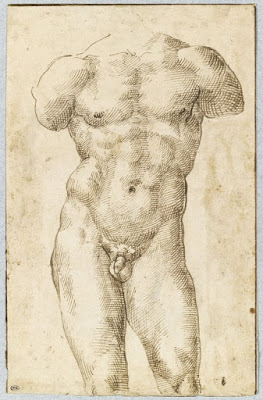 |
| Baccio Bandinelli Torso of Hercules, after Antique Statuette ca. 1511-15 drawing Musée du Louvre |
 |
| Baccio Bandinelli Hercules with Apples of the Hesperides ca. 1545 drawing Musée du Louvre |
 |
| Baccio Bandinelli Hercules with Lion Skin ca. 1545 drawing Musée du Louvre |
 |
| Baccio Bandinelli Study for Hercules ca. 1526-34 drawing Musée du Louvre |
 |
| Baccio Bandinelli Study for Atlas ca. 1521-23 drawing Musée du Louvre |
 |
| Baccio Bandinelli Figure Study, after Antique Vase Painting ca. 1550 drawing Musée du Louvre |
 |
| attributed to Baccio Bandinelli Figure Study, after Antique Statue before 1560 drawing Musée du Louvre |
 |
| Baccio Bandinelli Study of Kneeling Figure ca. 1539-40 drawing Musée du Louvre |
 |
| Baccio Bandinelli Study of Kneeling Figure with Urn ca. 1526-34 drawing Musée du Louvre |
 |
| Baccio Bandinelli Sleeping Figure, after the Antique before 1560 drawing Musée du Louvre |
 |
| Baccio Bandinelli Figure Study before 1560 drawing Musée du Louvre |
 |
| Baccio Bandinelli Figure Study for Massacre of the Innocents ca. 1520-21 drawing Musée du Louvre |
 |
| Baccio Bandinelli Figure Study for Massacre of the Innocents ca. 1520-21 drawing Musée du Louvre |
 |
| Baccio Bandinelli Figure Study for Dead Christ, after Antique Relief ca. 1552 drawing Musée du Louvre |
 |
| Baccio Bandinelli Neptune ca. 1540 drawing Musée du Louvre |
 |
| Baccio Bandinelli Two Studies after Antique Statues ca. 1540-60 drawing Musée du Louvre |
 |
| Baccio Bandinelli Two Studies of Figures in Motion before 1560 drawing Musée du Louvre |
 |
| Baccio Bandinelli Studies of Three Figures ca. 1529 drawing Musée du Louvre |
 |
| Baccio Bandinelli Men battling Centaurs, after Antique Sarcophagus before 1560 drawing Musée du Louvre |
 |
| Baccio Bandinelli Group of Figures reacting with Fear before 1560 drawing Musée du Louvre |
Baccio Bandinelli (1493-1560) – Ambitious but neurotic and technically deficient Florentine sculptor, who was an early (1530s) proponent of academic training. A portégé of the Medici from their return to power in 1512, he became, in all but name, court sculptor to Cosimo I after Michelangelo's final departure from Florence in 1534. His monumental Hercules and Cacus of the same year (Florence, Piazza della Signoria) designed as a pendant to Michelangelo's David was deservedly criticized, not least by Bandinelli's bitter rival Cellini. Trained by his father as a goldsmith and inlay expert, Bandinelli was apprenticed to Rustici, but, despite his ability to attract major monumental commissions, remained most successful working on a small scale and as a draftsman and carver in relief. . . . Temperamentally and technically ill-equipped to produce naturalistic and expressive statues in the Florentine tradition, Bandinelli was able, however, to copy well from the antique.
– Erika Langmuir and Norbert Lynton, Yale Dictionary of Art and Artists (2000)